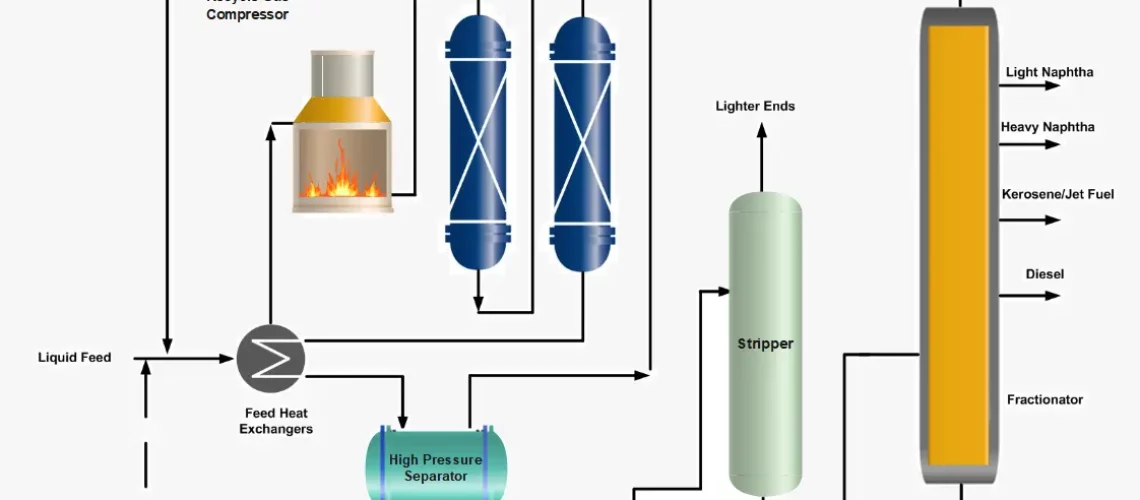Conversion in Hydrocracking units means how many highly valuable lighter products are produced from the residue feeds. Conversion defines the performance and severity of the hydrocracking operation, which has an impact on the catalyst temperature and stability. It is always preferable to produce more valuable diesel products and minimization of lower demand products such as gases, naphtha Kerosene and unconverted oil.
High conversion can be economical to some extent but can also lead to severe problems to the unit operation. The key is the balance between reactor severity and other operating conditions of the unit. For smooth unit operation, keep an eye on the operating conditions described in this blog and reduce reactor temperatures as they cross the safe operating limit.
Fixed-bed downflow reactors are widely used for hydrocracking feedstocks such as VGO and heavy gas oils from the coker. The process employs high pressures (70~200 bar), high temperatures (350~420°C) and multiple catalysts in the presence of hydrogen to obtain high-quality products from poorer quality feedstock, thus adapting to current refining trends and the need to process opportunity crude oils to obtain high margins.
The normal conversion range of Hydrocracking units ranges from 40~90 %. High conversion means we will draw more than the design quantity of the most valuable diesel product from the fractionation tower. When we pull more diesel then hot reflux is reduced resulting in making the diesel, kerosene and naphtha heavier. To make the distillation of the products within design, reactor severity has to increase.
Conversion Calculations for Hydrocracking Unit
The simplest method of conversion calculation for the once-through hydrocracking process is the gross conversion that depends upon the volume of unconverted oil from the bottom of the fractionation tower.
Gross Volume % Conversion = (Fresh feed Flow -Unconverted Oil Flow/Fresh Feed Flow) *100
Or Conversion=100-Fractionator bottom UCO volume %
e.g. Fresh Feed 200 m3/hr, while UCO is 50 m3, then conversion can be calculated as follows;
Gross Volume % Conversion = (200-50)/200*100= 50% conversion
Alternative Method= 1- (100/200) *100 = 50 %
Similarly, yields of individual products, like diesel, kerosene, Naphtha and gases can be calculated.
The volume conversion in a fixed bed hydrocracker can exceed 125 vol:% which is called Volume Swell. Economically, the volume swell is significant, because gasoline and diesel are sold by volume, not weight. Higher volume is worth more, regardless of weight.
Impacts of High Severity and High Conversion on Hydrocracking Unit
To achieve high conversion, a hydrocracking reactor’s high severity is required. The following, are some effects faced by the Hydrocracking unit during this operation;
1. Production of More Lighter Products
High temperatures in the reactor, will cause more cracking and as a result gases, naphtha and kerosene will be produced in high quantities thus disturbing the operating balance of the unit. In extreme cases, gases can go to flare if pressure is not controlled within time. Secondly, it will cause more production of naphtha and kerosene.
2. Foaming in Amine Scrubber
As a result of high cracking more gases will be produced and will go with the recycle gas stream from the high-pressure separator. The presence of more hydrocarbons in the recyle gas can cause foaming in the amine system thus disturbing the unit operation and in extreme cases, foaming can lead to compressor and unit shutdown.
3. Over-pressurization of Stripping Section
Due to the production of high lighter gases, the stripper overhead system will be over pressurized and as a result, the gases have to flare to control the system pressure. Further, the cooling system like fin fans and trim coolers will also overload.
4. High Load on Feed Heater
Owing to the high temperature of the reactor, the thermal load on the fired heater is increased. In extreme cases may limit the design conditions of the heater.
5. Highly Viscous Unconverted Oil
As more products are pulled from the fractionator tower, the unconverted oil will become more viscous and dense. At a high reactor severity, which causes aromatic structures in the asphaltenes to grow, aggregate and become unstable. This leads to mesophase and sediment formation, and fouling in the downstream separators, distillation towers and product heat exchangers.
6. Higher Catalyst Deactivation Rate
The deactivation rate on a Hydrocracking reactor is increased as reactor severity is increased. Higher conversions can reduce the life cycle of the catalyst. Please also view the blog “Avoiding Deactivation of Hydrocracking Catalysts“.
7. High Severity of Reactor
As the conversion of Hydrocracking units is increased it would require high temperatures of the reactor to obtain the desired product quality. Further, high reactor temperatures would cause the formation of polynuclear aromatics which would increase coke formation on the reactor of fouling of the downstream equipment and exchangers.
For further information, discussion, suggestions and queries please comment in the box below or contact us at admin@ or follow us on Facebook & LinkedIn.





